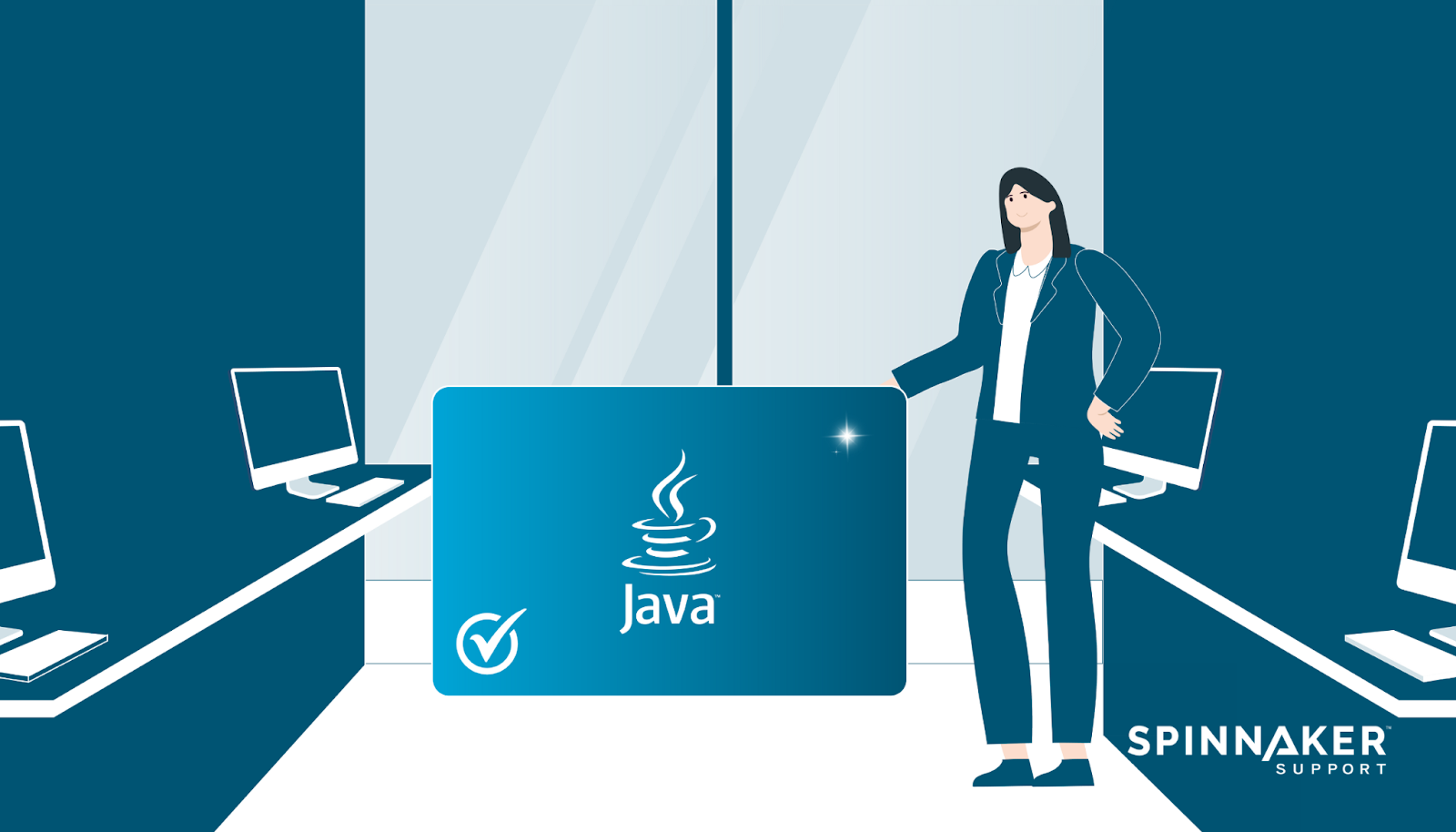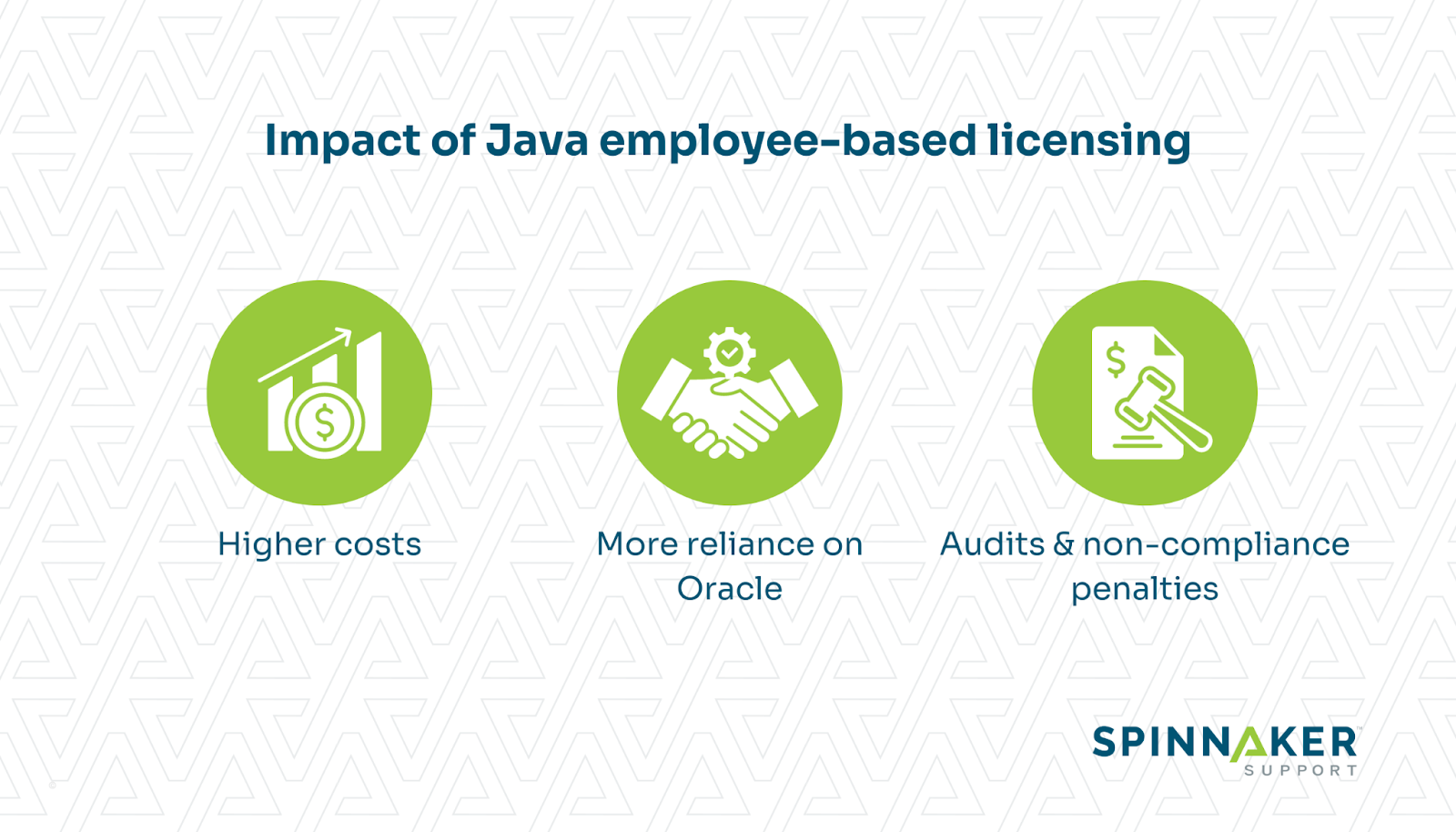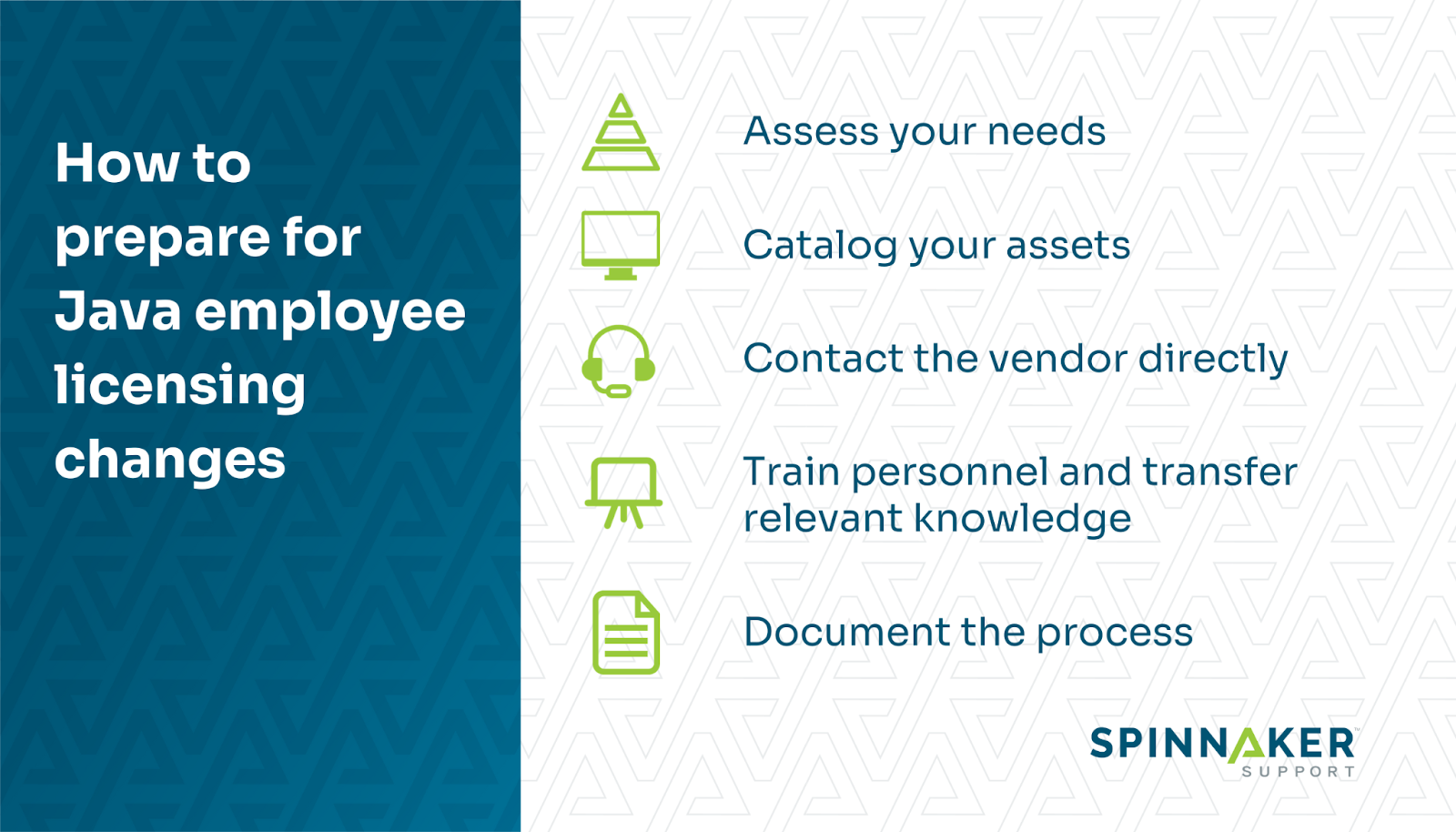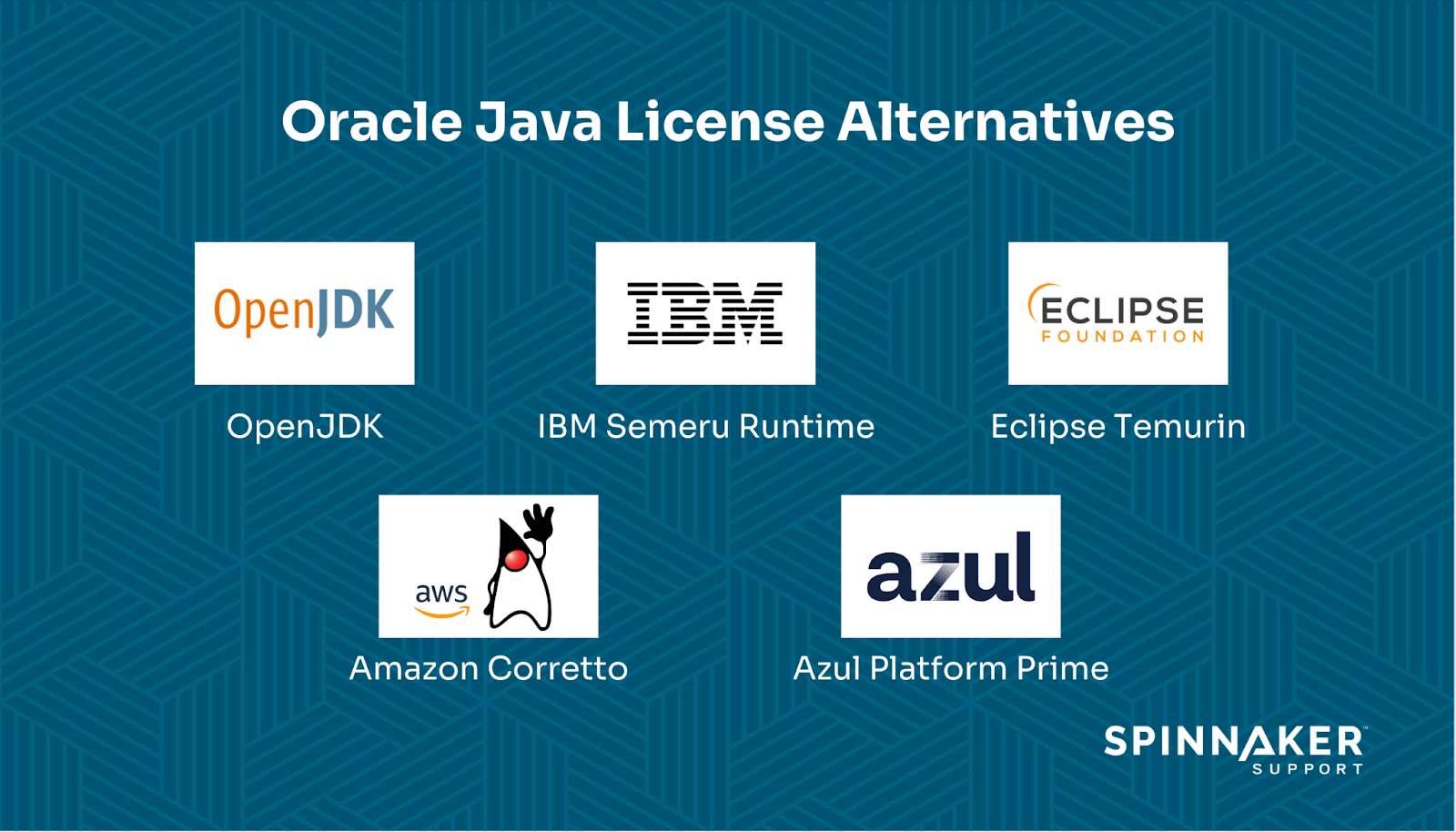
In 2023, Oracle announced an employee-based pricing plan for Java called the Java SE Universal Subscription. Existing and prospective customers need to understand how their employee numbers factor into the license, lest they risk hemorrhaging more money than they need to.
This article will take a closer look into the costs of the Oracle Java license, along with its key terms of agreement, now that it focuses on employees as a central metric. If the costs seem too steep or you’re worried about losing money to license disuse, there’s also information on how to rein in spending with a partner like Spinnaker Support.
What are the Java employee licensing changes?
The Java employee licensing changes Oracle introduced in early 2023 shifted the licensing model for implementing Java SE to an employee-based metric. Under the Java SE Universal Subscription terms, new adopters will need to pay to license Java for all their employees, whether they use it.
The agreement specifies that “employees” include full-time, part-time, and temporary employees, as well as contractors, consultants, agents, and companies you’re outsourcing to for your internal operations.
Finally, Oracle determines your employee count as what it was when you initially made your order, not when you eventually get access to the platform.
The model replaces the Named User Plus (NUP) agreement, which required you to license Java for every user with authorized access to the device on which it was installed, regardless of whether they used the program themselves.
How much does a Java license cost?
The cost of a Java license from Oracle depends on the number of employees you have. Here’s a quick breakdown:
- 1 to 999 employees: $15 per employee per month
- 1,000 to 2,999 employees: $12 per employee per month
- 3,000 to 9,999 employees: $10.50 per employee per month
- 10,000 to 19,999 employees: $8.25 per employee per month
- 20,000 to 29,999 employees: $6.75 per employee per month
- 30,000 to 39,999 employees: $5.70 per employee per month
- 40,000 to 49,999 employees: $5.25 per employee per month
If you have 50,000 employees and above, you’ll need to contact Oracle for pricing details and an additional license.
Let’s say you place the order when you have 1,543 full-time employees, 729 part-time employees, and an agency with 37 temporary employees working on your projects. Oracle would tally these up, and you’d end up with 2,309 people for which you’d need to license Java SE.
This places you under the $12 per employee per month bracket, which works out to $332,496 per year (2,309 employees x $12 per employee per month x 12 months) for your Java SE subscription.
How do these changes impact your business?
The most obvious impact of the move to an employee metric is increased Java license costs. Experts estimate that companies will pay between two and five times more than they currently are for Java licensing.

Oracle also recently started auditing Java licenses, and this might mean hefty noncompliance fees for companies that don’t adopt the new agreement wholesale. Over 50% of software licenses that companies pay for go unused, and this move is undoubtedly contributing to the problem.
These might come across as strong-arm tactics that companies feel they have to comply with, resulting in increased reliance on Oracle. Luckily, we provide several services to meet these challenges head-on, including:
- Consulting to figure out the best way forward that isn’t dictated by the vendor.
- Managed services, so you’re not dealing with the financial and logistical burden of having to run the Java programs internally.
- Third-party support, so you’re not reliant on Oracle’s first-party support.
- Compliance assessment and audit defense to fight off frivolous noncompliance penalties.
Just so you understand what we’d bring to the table in this regard, we’ve helped our customers win 95% of audits from Oracle.
How to prepare for Java employee licensing changes
Oracle is going full steam ahead with the Java SE Universal Subscription.

Here’s how you can prepare your company for the new Java licensing changes.
1. Assess your needs
Lay out your needs and compare them to the ways a subscription promises to meet them. In many cases, you’ll find that Oracle’s agreements aren’t enough for your company’s specific requirements.
Let’s take a basic need like security. Oracle gives you security patches, which sounds good, but these are often deployed on an untimely schedule, are one-size-fits-all, and usually only cover the latest software versions. In contrast, our Seven-Point Security Solution is better equipped to address your unique security demands.
We recently helped a customer move from Oracle support to our third-party support after the vendor began phasing out their version of Enterprise Business Suite. We offered to perform a vulnerability assessment, valued at over $10,000, on their system and provided a host of recommendations.
We found some vulnerabilities that hackers are known to use and got our Oracle experts to address them as soon as possible. Had they stayed on Oracle Support, these issues would likely have gone unnoticed and unaddressed.
2. Catalog your assets
“Assets” here refers to both employees and processors because those are the metrics Oracle uses to determine pricing. Remember that the number is what you have at the time you place the order, so you can take steps to manage the quote. You could, for instance, wait until your temporary employees have left or you’ve decommissioned older processors before placing the order.
3. Contact the vendor directly
Industry experts have characterized Oracle’s terms as “challenging to navigate,” and this is likely by design. For your own benefit, reach out to the vendor directly for as much clarification as you need before committing so you don’t lock yourself into an unfavorable contract.
An even better strategy would be to enlist the help of an experienced partner like Spinnaker Support, whose years of navigating Oracle’s complex agreements would give you the upper hand during negotiations.
4. Train personnel and transfer relevant knowledge
Ensure a smooth transition by transferring as much of the knowledge from the previous system as possible. From the system administrators to the people accessing the programs directly, make sure everyone is on board with the new model and how it’s different from the previous one.
You can make this easier if you sign up for our managed services for Oracle. We’ll handle everything in the background so the people at the front of the house don’t experience any speed bumps during and beyond the transition period.
5. Document the process
If you do move to the Universal Subscription, capture as much information as you can during the change process. This information will help you build a more in-depth overview of the system that comes in handy when handing responsibilities over to a managed services and/or third-party support provider like Spinnaker Support.
It’s the smartest move to make for anyone on the Universal Subscription — for Oracle customers, our third-party support alone saves 60%, significantly offsetting the higher licensing costs.
Which version of Java is still free?
Oracle still provides certain versions of Java for free under specific licenses, of which there are currently three active ones:
- GNU General Public License (GPL)
- Oracle Technology Network (OTN)
- No-Fee Terms and Conditions (NFTC)
The NFTC agreement, introduced in 2021, provides the full Oracle JDK, from Java 17 onward, under the following terms:
- You get access to the whole of Oracle JDK, including quarterly security updates.
- You can use it internally for any purpose, including commercial.
- You can distribute the program as long as you do it for free.
- You can’t decompile, reverse engineer, disassemble, or otherwise modify the source code unless you have a separate license that allows you to do so.
- You can’t remove notices of Oracle’s ownership from the program or documentation.
The GPL and some implementations of the OTN licenses cover OpenJDK, a free and open-source variant of Java SE that’s also developed in part by Oracle, discussed briefly below.
What is the alternative to an Oracle Java license?
You might feel frustrated with the new Java licensing changes.

Some alternatives to the Java SE Universal Subscription include:
- OpenJDK: This is a free and open-source variant of Java SE developed by Oracle, Red Hat, and the JDK dev community. It lacks features from the full version of Oracle JDK, including Flight Recorder and advanced Garbage Collection. You can use the vanilla implementation of JDK to build your own binaries for Java development.
- IBM Semeru Runtime: Semeru provides no-cost binaries on which you can run Java applications. They’re production-ready, built using the Eclipse OpenJ9 JVM and class libraries from OpenJDK.
- Eclipse Temurin: Eclipse Temurin is a rigorously tested distribution of OpenJDK from Adoptium, a group whose goal is providing free and open-source tools for Java development. The project is backed by major tech industry players like IBM, Alibaba, Microsoft, Red Hat, and Huawei. Compared to most of its competitors, it runs on more platforms, such as mainframes.
- Amazon Corretto: Corretto is a free Java Technical Compatibility Kit (JTCK)-certified build of OpenJDK, developed and backed by Amazon. The company also uses it internally and positions it as a more stable version of OpenJDK with improved memory management, garbage collection, reporting, and thread management.
- Azul Platform Prime: This is a performance-optimized Java runtime that seeks to smooth out basic inefficiencies in cloud deployments. Its pricing starts at $6,000 per year for 250 vCores.
Like Oracle Java SE, these alternatives have their strengths and weaknesses, and what works for one business might not be ideal for the next. Our technical and application consultants can help you figure out which one is right for your company and provide you with the right strategy to adopt it.
We recently did just this for a health insurance company out of Colorado that wanted to move away from Oracle to proprietary technology. We took full control of their support needs in the interim, from security and vulnerability management to technology advisory services, while providing 59% in savings.
Conclusion
Oracle recently shifted its Oracle Java pricing model to an employee metric where you’ll need to pay for all your employees, not just the ones that use it. Researchers have estimated that this could cost companies between two and five times what they’re currently paying for the license.
Our managed services and third-party support reduce your reliance on Oracle, while our audit defense and compliance assessment services stave off hefty noncompliance penalties. We also provide security solutions that protect both new and legacy versions of software effectively.
Contact us today to discuss how to get the most out of your Java license.




